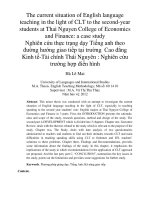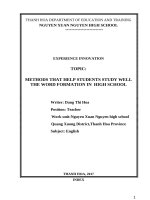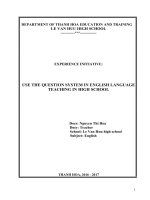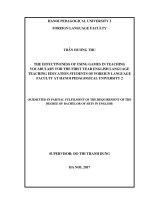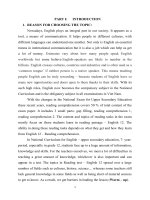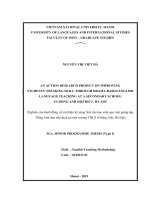Use the question system in english language teaching in high school
Bạn đang xem bản rút gọn của tài liệu. Xem và tải ngay bản đầy đủ của tài liệu tại đây (492.8 KB, 24 trang )
DEPARTMENT OF THANH HOA EDUCATION AND TRAINING
LE VAN HUU HIGH SCHOOL
------------***--------------
EXPERIENCE INITIATIVE:
USE THE QUESTION SYSTEM IN ENGLISH LANGUAGE
TEACHING IN HIGH SCHOOL
Doer: Nguyen Thi Hoa
Duty: Teacher
School: Le Van Huu high school
Subject: English
THANH HOA, 2016 - 2017
1
CONTENTS
I. INTRODUCTION
1.Reasons for choosing this topic.
2.Aims of the study.
3.Object of the study.
4.Methods of the study.
5.New points.
II. CONTENT
1.Rationale.
2.Practical basis.
2.1- Teachers.
2.2- Students.
3.The measures have been taken to solve the problem.
3.1- Find out the function of the question:
a- Introduction phase of the language
b- stage of practice
c- Stage of evaluation evaluation
3.2-The tips to ask questions
a- Closed-Questions
b- Open Question
c- Suggested Questions
3.3- How to use a questionnaire
a- Exploit available students door
b- The linking questions between the chalk in the post
c- Questions for staging contextual situations.
d- Questions to extract the vocabulary needed for the task
e-Hint questions
f- Reading comprehension, listening comprehension
3.4- How to conduct the question
3.5- Some points to keep in mind when using the question in front of the class
4. The effectiveness of the experience initiative.
III.CONCLUSION AND RECOMMENDATIONS
1. Conclusion
2. Recommendations
IV- REFERENCES
2
I. INTRODUCTION
1. Reasons for choosing this subject.
In the process of industrialization and modernization, in the reality of the
developing country to integrate into the international community of ASEAN
countries as well as other countries in the world, especially our country. Having
officially become a member of the WTO, knowing and using at least one foreign
language is an urgent need, a necessity for each of us. The decisive factor in the
success of industrialization and modernization is that the resources of the
Vietnamese people are developed in quantity and quality on the basis of
improved intellectual level. Therefore, the education and training of our country
has also changed from education and training to teaching and learning methods
in order to effectively contribute to the preparation of human resources of the
country. In the first decades of the 21st century, learning foreign languages in
general and learning English in particular has become and will become a hot
topic for people of all ages, gender and all levels. .
During the past school years, we have been innovating teaching and
learning methods, innovating textbooks, combating copying such as classical
teaching methods, teachers often use in-depth methods. For this reason, students
must change their learning style and prepare better, more thoroughly, and at the
same time the teacher must meet a variety of teaching methods. We need to
apply many tricks in the system of tricks so as to achieve high efficiency in
students' ability to develop their linguistic abilities. Teach students to logically
learn the lesson, after a period of study, learning, learning Especially in a reallife course taught at Le Van Huu High School With my own thoughts, I boldly
put up a small experience" Use the question system in English language teaching
in high school " to exchange together.
2. Aims of the study.
With successful research, this experience will help teachers gain the following
main purposes:
- inspire interest for the students in the class.
- Instruct the students to practice themselves to develop their language
skills.
3.Object of the study.
Classes 10A8, A9, Bl, B5 Le Van Huu High School through English classes.
4.Methods of the study.
Mainly based on practical teaching and self-experience. Through peer-to-peer
exchange and study of relevant documents.
5. New points.
In order to meet the needs of the society, the universal education must promote
self-discipline, self-awareness, initiative and creativity of the learners. Put into
the practice, affect the personality, bring joy, interest in learning that formed
capacity and quality. Therefore, to create excitement for students I have
3
researched the new questioning tips to open, encourage the learning spirit of
students such as Closed-Questions, Open- Question ,Suggested Questions.
II. CONTENT
1.Rationale.
In general teaching and English in particular, question plays an important
role to be used as a popular tool and is almost indispensable in every classroom
lesson. Song said so, his questions are not always the results as expected. If we
observe the teacher's question during class, it takes up most of the time. There
are cases where, in many parts of a unit, questioning is the only one trick in an
instructional session. In general, familiar questions to the teacher are often
questions to check. For example: Check the old post, check the comprehension
level, grasp the lock, check the grammar grip, vocabulary ....
Also due to the "test question" concept, most of the time the main
questioners are still teachers. Very rarely students have the opportunity to ask
questions, unless it is a case of student grammatical questions, or questions that
students want to explain to the teacher. This situation leads to the following
negatives:
- Students have no training conditions, use meaningful communication
questions.
- The way students learn passive behavior, lack of initiative, lack of
opositive ...
- The question is emotional, not focused and not scientific teachers have
not as effective as expected.
Thus, in order to achieve effective use of the question, teachers must have
a method for questioning and using the question system in a scientific way. To
guide students, engage their concentration during school.
2.Practical basis
2.1- Teachers:
The school currently has 8 English teachers. Most of the comrades are
experienced, enthusiastic in teaching and all have the required standards.
2.2- Students:
Most students of Le Van Huu High School were born and raised in rural
areas so the conditions of study are not good, the time is limited and the English
communication environment is limited. Secondary school subjects A, B should
not really study hard, hard to memorize the word, flexibility, creativity is not
high, the way to learn passive behavior.In addition English is also a difficult
subject. Students must master the four basic skills: listening, speaking, reading,
and writing. At the same time, students must also be familiar with the basic and
systematic knowledge of modern English practice. With age as well as a general
understanding of British culture it is a challenge
Before applying the subject, I was able to summarize some of the students'
understandings of the lesson through the use of teacher-led questions as follows:
4
Class
A9
A10
B1
B5
Total
students
38
38
38
46
positive attraction
normal attraction
No attraction
SL
10
9
10
15
SL
20
20
19
21
SL
8
9
9
10
%
26
24
26
32
%
52
52
50
55
%
22
24
24
13
3. The measures have been taken to solve the problem.
3.1 Find out the function of the question:
To use the question in a scientific way, the teacher must first understand
the function of the question. The question is used for different purposes in each
stage of the teaching process.
a-Introduction phase of the language
During this phase, questions are used to:
- Inspire students before the lesson
- Deploy students into new assignments
- Creating situation, context, introducing the lesson
- Create communication needs
- Clarify the need for practice
- Tutorial guidance, help students master new material
- Check the level of understanding of the newly introduced language.
b-stage of practice
The question is used to:
- check comprehension or listening comprehension
- practice new material
- suggestive guidance, focus students attention on the main content or the
content to detect to understand better.
- Practice listening and speaking skills.
- Get feedback.
c-Stage of evaluation evaluation
At this stage, use questions to assess the level of comprehension of
students as well as test their knowledge.
3.2. The tips to ask questions:
In the process of teaching and learning. The teacher is the one who raises
the question and the student always wants to answer the teacher's question. Here
are some ways to ask questions that can help students understand and speak
English more easily.
The work of the teacher is to check the level of understanding of the
student. Song raises the question: "Do you understand?" Not a good question.
Because students will answer "Yes". Students sometimes respond to this because
they may not want to disappoint the teacher or show unfavorable results for both
5
teachers and students. So in my opinion, teachers should ask questions that can
test the understanding of the students. Here are three basic tricks.
a- Closed-Questions
In this enumeration, the teacher should ask "Yes / No questions". This
may be the easiest way for teachers to get their feedback quickly.
For example: In Reading 3, page 33 of English textbook grade 10, teacher
can ask questions to explore the level of reading comprehension of the students
with the following questions:
- Did Marie go to school in Warsaw?
- Was her dream to become a private tutor?
- Was she the first woman professor at the Sorbonne?
Example;In Writing –unit 8, page 87 of English textbook grade 10,
teacher can ask questions to lead in the new lesson:
-Have you ever found the way to somewhere?Is it difficult for you?Can
you follow the directions with a map?
Example;In Listening –unit 10, page 107 of English textbook grade 10,
teacher can ask questions to introduce the topic:
-Have you heard about the forest fires recently? In Vietnam and in other
countries,for example,in Australia?
-Do you know the reasons why they happened?
So this question form is very easy for students. By simply comparing the
words of the question to the content of the readings to answer "Yes" or No.
b- Open- Questions
Another trick in asking that question is that we use questions beginning
with: What ...? Why ...? When ...? Where ...?
As with the lesson content in the example above, we can ask:
- Where did Marie go to school?
- Why did she work as a private tutor?
- Who was the first woman professor at the Sorbonne?
c- Suggested Questions:
The question prompts the teacher to give some simple questions to guide
students to finding the answer by their own inference. Often these questions
require students to use their deductive imagination with situations. Sometimes
simple tricks when explaining to students the content of the lesson. Students
should learn to brainstorm.
Example; In part 1 Reading page 13 of English textbook grade 11 can ask
the question:
- What do you think about the friend in the poem?
- What qualities should we have to have true friendship?
With illustrated lessons you can also take pictures asking students to guess.
For example, in lesson 2 of listening on page 27 of English textbook
grade 11 might ask:
- Can you see fire?
6
- What's burning?
- Can you see a woman?
- What's she doing? / Who's she carring in her hands?
- Do you think they are from the burning house?
- How do they look?
3.3 How to use a questionnaire:
a- Exploit available students door
Prior to the entry of any content, the teacher may offer some suggestions
for exploring the available knowledge of the student. At the same time, direct
the attention of the children to lead them into new content.
With the content of learning how to learn reading or listening, the use of
the available resources for student exploration is a good example. The main aim
of these questions is:
- What do you know?
- Do you want to find out more?
Example: In Reading Reading section 11, page 113 of English textbook
grade 11 ask the following questions:
- What do you know about Cuc Phuong National Park in Viet Nam?
- Where is it? How big is it?
- What is it famous for?
- What do you want to know about it?
- Read and find out the answers.
Example:In Listening section unit 8, page 86 of English textbook grade
10,teacher ask some questions to summarize the content of the lesson:
-Do you remmeber where Popffero is?
-What has it become now? Is it quiet and peaceful?
-How different is it from the past?
-Do all the people in Popffero like the changes?
Students then read the article, comparing the available insights with the
content of the article to gain new insights.
b- The linking questions between the chalk in the post
At the pre-entry stage, teachers may also ask questions that students may
be able to answer, and students must perform a task or follow-up request such as
reading, listening, asking or answering. interview. In other words, this question
makes for a more motive of reading, listening, and speaking, as a problem set
out to solve, and thus making the meaningful exercise
For example:
- Do you know?
What is the purpose of Spring School? (Listening page 51 English
textbook grade 11)
Listen and find out.
- Does your friend like these things?
Talk to him and find out.
7
Example:In speaking section unit 12, page 126 of English textbook grade
10,teacher ask students to work in pairs :
Teacher gives the model:
T: What kind of music do you like?
Ss:I like pop.
T:Why do you like it?
Ss:Because it is relaxing.
T:Who is your favorite band or singer?
Ss:Micheal Jackson.
T:What song do you like best?
Ss:Thriller.
T:When do you often listen to it?
Ss:Whenever I have free time.
c- Questions for staging contextual situations
These questions are often accompanied by pictures.
Example: In Reading 2, page 22 of English textbook grade 11, Teacher
can ask the following questions:
- Who do you see in this picture?
- What's the girl wearing on her head?
- How does the hat look?
- What's the man doing?
- What's on the table?
You can see the same girl in all of the other pictures.
- Where is she?
- What is she doing there?
- How is she feeling?
-What is she thinking about?
d- Questions to extract the vocabulary needed for the task:
Example: In Lesson 2 of Writing on page 19 of English textbook grade 11
Teacher asks students to think of the words which they add to the following lists
to decribe a person.
+ Appearance: tall, short, thin ...
+ Character: Friendly, helpful ...
+ Habits: get up early, stay up late…
+ Ask if these are true to your friend?
+ He / she has a stamp collection.
+ He / she is a good chess player
+ He / she plays table tennis
+ He / she is a computer expert
+ He / she swims very well.
e- Hint Questions:
8
These are open-ended questions that help students contribute their ideas,
contribute information and insights to better understand, practice using better
language.
The open question has the following positive ones:
- Through the questions posed, students are actively engaged in the
lesson, the time the students are talking in the class increases.
- Suggestions to raise the students 'well-being, consolidate and develop
the students' thinking, learning strategies.
- Lessons are more attractive and interesting to students, because they
have better motivation to learn.
- It is a means of checking and timely responding to the necessary
information for the teacher to grasp the level of understanding of students such
as: Students who understand the good lessons, which students need more
support ...
So how to exploit this kind of question?
Suggested questions to help students better understand: This is a small,
easy-to-follow quiz to help students find answers to questions. Suggested
Questions Help Students Understand Totals: This is a small, easy-to-make quiz
that can help students find answers to more difficult questions while learning a
lesson. These types of questions are often deliberately arranged by the teacher so
that the questions step by step prompt students to understand a great deal of
content.
Example: In lesson 7 on page 80 of English textbook grade 11 teacher can
ask the following questions:
- Who can you see in the first picture?
- How many children?
- How is the house which his family live in?
- What does the man do to earn his living?
- What do the two pictures tell you?
* Suggestion questions test concept, meaning of words.
At the stage of introducing new intonation, an important step is needed
before the training stage to check the level of capturing the meaning of that
language.
One of the tricks of language understanding at this stage is to ask a series
of questions around the meaning of the material.
* Check the meaning of the grammatical structure.
Example: In lesson 1, focus language page 21 of English textbook grade 11
Mary wanted to borrow a French book yesterday
The questions could be:
+ When did John want to borrow a Frenh book?
+ What are the last two letters of the verb "want"?
Etc ...
f- Reading comprehension, listening comprehension:
9
This is the type of question most commonly used by teachers for their
listening and comprehension skills. However, in order to effectively use these
questions the teacher also needs to understand the types of questions and the
difficulty level of those types of questions. The types of comprehension and
comprehension questions can be summarized as follows:
* Question types divided by morphology, structure.
- Yes, no Question
- Or-Question (altennative questions)
- Wh- Question
- How Question
- Multiple choice
- True / False
* Type of questions divided by the content of the answers.
- Questions are answered by directly retrieving the sentences available in
the text.
- Questions are answered with the information selected in the lesson.
- Questions are answered with indirect suggestions in the article
- The questions require the evaluation inference to answer.
In practice, the difficult or easy question does not necessarily depend on
the complexity of the structure of the question, but also on the level of response
required (as mentioned in section b).Teachers should combine these two
elements to create the right questions for the students.
3.4. How to conduct the question:
In addition to mastering should use the question is, in any case. Teachers
also need to know how to organize the activity of the question and answer to
overcome the disadvantages as stated in the beginning. Specifically, the teacher
must consider the problems in questioning such as: Who to ask? Ask what? Ask
students to raise their hands or not raise their hands? Or like: Who asked?
Teacher asked or asked: Ask how? In group or pair? Ask in front of the class or
bald spot? In general these are issues that need to be considered by the teacher in
each specific situation, with each specific subject. There is no best or only way.
Depending on the specific situation, depending on the specific student object,
the teacher selects the appropriate question form. Otherwise these questions will
be embarrassing for students.
Here are some suggestions:
* Use the questions to gather the whole class intention, requiring the
class to work.
Eg:
- What are we studying this part?
- Do you know about,.?
- Who can tell me about ...?
`* Use questions that weak students have the opportunity to answer.
In lesson 1, speaking-task2 page 15 of English textbook grade10 can
10
ask the following questions:
- What is his name?
- What does he do at 2 p.m?
- What time does he read books?
- Does he watch TV at 16.30?
Etc ...
For a short answer question, ask the whole class to answer freely. Then
call the personal check.
* Always change the questioning mode
+ Teacher - student
+ Student - student
+ Student - teacher
If the questions are done in the classroom, use the intersection of the
students. That means not to have the two students sit together to ask each other,
for students to ask this row ask the students sit side by side. Song must also note
the location of the students as appropriate.
*Highly motivated students should be encouraged to substitute classroom
teachers to ask other students in a suitable case book.
3.5. Some points to keep in mind when using the question in front of the
class:
Using the question system while teaching English is extremely important
and effective. The lesson will be lively, attractive, help students understand
better absorb better. Teachers will also have to take note in using the question,
otherwise the questions themselves will be counterproductive, which will take
time. So before the lesson, ask the teacher to thoroughly prepare the system of
questions or suggestions, outline for students to practice in the most reasonable
and effective way. Depending on each lesson content as well as each student
object to use the question properly. For weak students we should use simple,
easy-to-understand questions. But for good students we have to use more
difficult questions that are creative inferences. However, we should not ask too
hard questions, too the ability of students. If so, students will feel bored or afraid
to learn. For students we have to give specific instructions on how to study as
well as prepare the homework.
We should not attach too much importance to a method, but we need to
know the harmony of teaching methods and teaching techniques. At the same
time, to use everything around in the lecture, such as: desk, listening, books ...
either teachers themselves or students in class. Yes, any class will be effective.
The following I would like to present two lesson plans where I have
applied some of the techniques described above along with the lessons learned
plus self-experience, hope for the approval of the science council, colleagues
and students.
11
UNIT 2: SCHOOL TALKS
Lesson C: Listening -Period 9 –class 10A10
I. OBJECTIVES:
1. Aim: -Help students to listen to the conversations and match them with the
pictures.
-Help students to listen and complete the conversation
2. Knowledge: Students will be able to make mini conversation about daily
topics such as: study at school, weather, ...
3. Skills: Listening
II. Method: Intergrated, mainly commmunicative.
1. Teaching aids: textbook, workbook, chalk, Cd player.
III. PROCEDURE:
. 2. New lesson:
Teacher's activities
Students' activities
WARM UP (5-7mins): Requires Ss to listen and find the questions for the
find the questions for the answers
answers
1.I’m taking English.
Work in pairs
Expected answer:
2.I really like it
1.What are you taking this
3.For two weeks.
semester?
4.No,I’m travelling alone
2.Do you like travelling ?
5.That’s great.
3.How long are you staying there?
Asks Ss to work in pairs
4.Are you travelling with your
Calls some pairs to give answer
parents ?
Checks and corrects
5.Would you like to go somewhere
New lesson (35-37mins)
for a drink?
I. Before you listen
- requires Ss to work in individuals
and then work in pairs
work in individuals and then in pairs
- walks around for help Ss
- checks and gives the right answers to do the task
* Expected answers:
II. While you listen
1-c, 2-e, 3-a, 4-b, 5-d.
Task 1 : Matching(10mins)
Asks Ss to listen to the conversations and
match them with the pictures
-Asks students to look at the pictures and
answer the question
+What can you see in the picture?
-Look at the pictures
+Picture a:
I can see some people standing
in front of the hotel
+Picture b:
12
+Where are they?
+What are they talking about?
I can see some people and
classrooms
+Picture c:
Birthday cake,candles,gifts…
A.They are at the hotel
B.They are in school
C. They are at a party
D.They are standing on a beach.
-Ask them to guess the answers
-Play the tape once then check how many
answers can students find.
About
subjects,classes
teachers…
Plays the tape more than once
-Check and give remarks.
-Call some sts to say out their answers
and the evidences they get to prove their
answers.
- listen to the tape and do the
task.
- find evidences to each of the
answers.
Task 2:Answer the questions (10mins)
-Ask some questions
Do you know?
+ What subject is Lan talking this
semester?
+Whose class is Lan in?
-Ask them to guess the answers.
-Play the tape once then check how many
answers can sts find.
-Play the tape again.
-Check and give remarks.
-Call some students to say out their
answers and the evidences they get to
prove their answers.
Task 3
Conversation completion( 6mins)
-Asks Ss to work in pairs and study the
conversation. Encourage them to guess
the missing words
-Plays the last conversation again
-asks Ss to listen to it and complete the
conversation by filling in the missing
words
-Calls some pairs to give answer and then
and
* Expected answers:
conversation1 – picture b,
conversation 2 – picture c,
conversation 3 – picture d,
conversation 4 – picture a
-Individual work.
-read all the questions to get the
main contents.
-Listen to the tape and do the task.
-Find evidences to each of the
answers.
*Suggesting answers:
1. She is talking English
2. She is in Miss Lan Phuong’s
class
3. He is at a party
4. He plans to stay in Nhatrang for
week.
5. No, she dosen’t. she traves
alone
13
to practise the conversation
-Comments on Ss’ performance and gives -listen to the CD and complete the
correct answers
conversation
-give answers
*Suggesting answers:
III. Post- listening(6mins)
Asks Ss to work in groups and discuss the
problems they have experienced at school
suggests the common problems at school.
advises Ss to use these questions :
What problems have you got at school?
What is / are the reasons ?
What have you done to solve it / them?
Who helps you to solve it?
- goes round to help Ss
- calls some Ss to talk about their
problems at school
checks and corrects if necessary
IV.Consolidation (1min)
-Ask. Sts to summarize the main point of
the lesson
V.Home work (1min)
-Write a conversation about the problems
you have experienced at school
-Prepare next period, unit 2-Writing,
1.
2.
3.
4.
5.
6.
7.
8.
it here
very nice
big
comfortable
travelling
no
alone
for a drink
-listen to the T’s help
-use these suggestions to do this
task
give answers
-Suggest the common problems at
school:
getting bad marks, having
difficulty in making friends,
coming to class late, ...
work in individuals
UNIT 8: THE STORY OF MY VILLAGE
Lesson B: Speaking -Period 47-class 10A9
I.OBJECTIVES
By the end of the lesson, students will be able to talk about plans and their
possible results.
1. Education aims:
2. Knowledge:
a. General knowledge: - Students can talk about plans and results.
b. Language:
-"Should" and conditional sentences type 1
-Vocabulary on the plan to improve life of a village.
3. Skills:
- Speaking about plan and results.
-Discussing plans to improve life in the village.
14
II. METHOD: Integrated, mainly communicative
III. Teaching aids:
Pictures, textbook, tapes, projector.
IV. Procedure:
Teacher’s activities
* Warm-up: (5 minutes)
- Shows a picture of Ha Xuyen village.
Students’ activities
- Discuss in pairs
- Take turns to talk
about Ha Xuyen
village.
- Asks students to look at the pictures and suggestion to
talk about Ha Xuyen village.
Road/ narrow
+ There/ no bridge/ in Ha Xuyen village.
+ The road/narrow.
- Raises the question:
What should we do to improve the life in the village?
- Leads in new lesson: Let’s practice talking about the
plans to improve the life in Ha Xuyen village and their
possible results.
I. Pre-speaking: ( 5 minutes)
- Teaches some new words through the pictures and
explanation.
+ resurface (v ):put new surface on, renew
1.There is no bridge
in Ha Xuyen village.
2.The road is
narrow.
- Listen and take
notes.
+ widen (v )
15
+ canal (n): man-made waterway for irrigation
+ muddy(a ): full of mud
- Asks some sts to read the new words in front of the
class.
- Gives the correct pronunciation.
II. While-speaking: (29 minutes)
Task 1: (10 minutes) The villagers of Ha Xuyen are
discussing plans to improve the life in the village.
Look at the pictures and say what they should do.
- Supposes students are Ha Xuyen villagers, give a
model:
A: What should we do to improve the life in the
village?
B: I think we should widen the road
- Gives more suggestion and asks students to produce
the similar conversations.
+ Widen the road
+ Build a new school
+ Build a bridge
+ Build a medical centre
+ Build a football ground
- Practise speaking in
pairs
- Read the model in
chorus
Ss:They should
widen the road.
Ss: They should
build a new school.
In the future
16
Ss: They should
build a new bridge.
In the future
Ss:They should build
a medical centre.
In the future
S7:They should build
a football ground
In the future
.
- Practice in pairs
17
- Read the plans and
results to find out
new words.
In the future
Task 2: ( 10 minutes)
Match each of the plans with its possible result
- Raise some plans and possible results:
* Plans:
1. Resurface the road
2. Build a medical centre
3. Build a football ground
4. Grow cash crops
5. Build a bridge
6. Build a new school
* Possible results:
a. Children will have better learning conditions; they
will be more interested in learning.
b. Villagers will have a shorter way to town; cars and
lorries can get to the village.
c. People’s health will be looked after better; the sick
will be cured in time.
d. Young people can play sports; people can hold
festival there.
e. People can export the crops; they will have more
money.
f. Roads will not be muddy and flooded after it rains;
people can get around more easily
- Presents new words.
- Asks students to match each of the plans with its
possible result
- Show the keys and correct the answers on board.
* Keys: 1-f; 2-c; 3-d; 4-e; 5-b; 6-a
Task 3: ( 9 minutes)
Produce conversations in pairs
- Work in pairs.
- Read the model
- Look at the pitures
and suggestion to ask
and answer in pairs.
A: What should we
18
- Gives model:
A: What should we do to improve the life in the
village?
B: I think we should resurface the roads
C: That’s a good idea. If we resurface the roads, they
won’t be muddy and flooded.
D: Yes. And people can get around more easily
- Lets students produce conversations in groups.
- Asks some groups to present in front of the class.
IV. Post-speaking: ( 5 minutes)
- Gives question relate to the fact
What should we do to improve our English?
do to improve our
English?
B: We should
practice English
everyday.
A: What should we
do to improve our
English?
B: We should speak
to foreigners.
Practice English everyday
A: What should we
do to improve our
English?
B: We should listen
to English tapes
Speak English to foreigners
19
Listen to English tapes
V. Homework: ( 1 minutes)
- Learn all new words by heart then make sentences
with them.
- Write four conversations in the notebook
- Prepare new word for listening lesson.
4.The effectivenes of the experience intiative.
After nearly a year of implementing the above teaching methods, I
followed and conducted the survey of student quality and obtained satisfactory
results. Most students are drawn to each stage of the lesson and understand the
lesson by providing sensible, appealing sentences.
Specific figures are as follows:
class
A9
A10
B1
B5
Total
students
38
38
38
46
positive attraction
normal attraction
SL
27
26
27
29
SL
8
10
8
10
%
71
68
71
69
%
21
24
21
26
No attraction
SL
3
3
3
7
%
7
8
7
5
III.CONCLUSION AND RECOMMENDATIONS
1. Conclusion
Learning is a long, hard work for students. Therefore, the teacher not only
gives the task of imparting knowledge but also must find ways to make the
lesson effective, attracting the attention of the children. It is very important to
teach them how to learn, especially to encourage them to use English in their
lives, with the fluency of English at the elementary level in high school that will
20
also contribute to the students. Learn better or find a good job later. However,
there are still many aspects to be discussed in order to find more feasible
measures on the basis of reasoning as well as practical experience to make
teaching work better and more effective.
The above are all the things I have studied, how to make students
understand the fastest, how to make the lesson become lively and the classroom
atmosphere is comfortable. Experienced teaching at my school formed this topic
with the expectation of colleagues to comment on the spirit of learning from
each other.
2. Recommendations
With the characteristics of the English subject, noisy in class is inevitable,
but it is useful noisy minutes. In fact, in my school this noisy will affect other
classes, because sometimes when students answer the questions in the different
situations, their psychology are very sensitive and hyperactive, sometimes they
can not control themselves, even they laugh loudly, clap ...... Therefore, teachers
must master dynamic role and resolve any unexpected situations that may
occur, they can practise effectively.
From my point of view, using the question system should be applied
more creatively to match the object which they teach. My initiative experience
above was gained from practical teaching myself in the past school year but I
present will certainly not avoid the limitations which need adding and
commenting.
I would like to hear the comments of all colleagues to make my subject
more complete!
I hereby declare that this initiative is due to the experience I myself
have written, not copy anybody’s. I sincerely thank you!
COMMENTS AND ASSESSMENT
OF THE SCIENCE COUNCIL
Thieu Hoa, May 15th, 2017
The author
Nguyễn thị Hoa
21
IV- REFERENCES
1- The methodology course (Book one)
2- The methodology course (Book two)
3-Marion Williams, A course in language teaching.
4. Nguyen Hanh Dung (2003 ), Methods of teaching English in
secondary schools, Educational Publisher.
5. Jeremy Harmer, How to teach English , Saigon Cultural Publisher .
6- English textbook 10.11
7.
22
23
24


